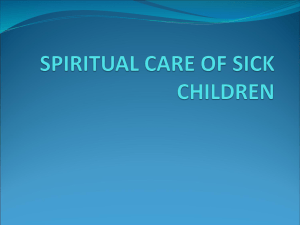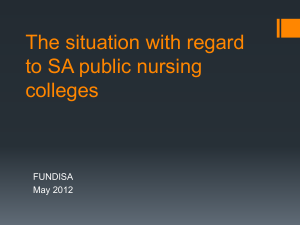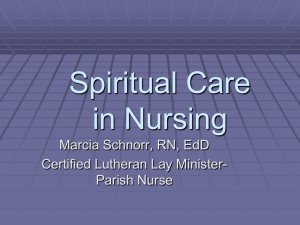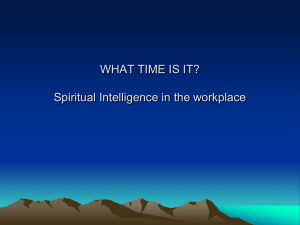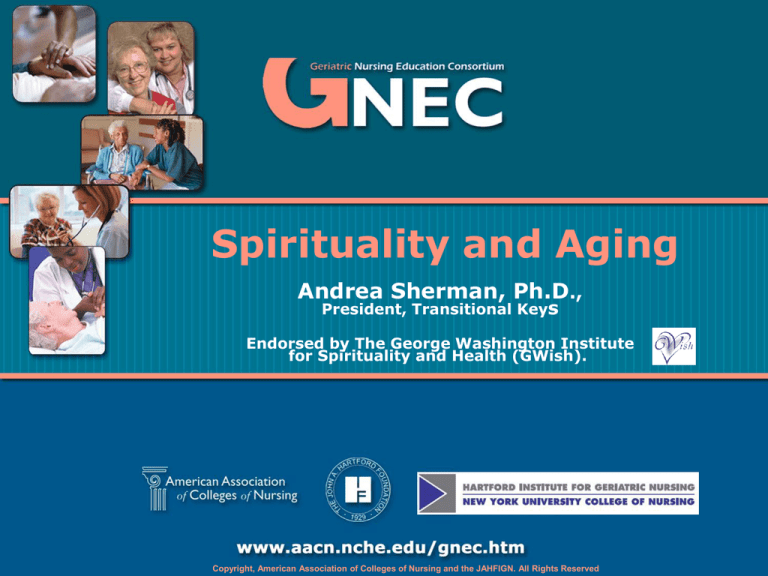
Spirituality and Aging
Andrea Sherman, Ph.D.,
President, Transitional Keys
Endorsed by The George Washington Institute
for Spirituality and Health (GWish).
Copyright, American Association of Colleges of Nursing and the JAHFIGN. All Rights Reserved
Learner Objectives
1. Discuss the vital role of spirituality in older
adults, and in patient/caregiver
relationships.
2. Distinguish between spirituality and
religion and the impact of culture.
3. Discuss the relationship of spirituality and
chronic disease.
4. Identify several methods for taking a
spiritual history and know when it is
appropriate to make such an assessment.
Copyright, American Association of Colleges of Nursing and the JAHFIGN. All Rights Reserved
Learner Objectives (contd.)
5. Describe when it is helpful to connect to pastoral care,
chaplains, and other spiritual advisors in different settings of
care.
6. Identify and discuss interventions of spiritual care including the
arts, story/reminiscence, and other therapies and modalities.
7. Understand the importance of self-care as a spiritual practice
and list techniques that are useful.
Copyright, American Association of Colleges of Nursing and the JAHFIGN. All Rights Reserved
Spirituality
Spirituality has many meanings.
Root-words (Hebrew, Latin and Greek): wind, breath, or air which
gives life.
Other word associations: Inspiration,
meaning, beliefs and values, nature,
connection, transcendent, purpose,
journey, pilgrimage.
Hope is an
important element
of spirituality.
Copyright, American Association of Colleges of Nursing and the JAHFIGN. All Rights Reserved
Spirituality
“Spirituality is that which allows a
person to experience transcendent
meaning in life…whatever beliefs and
values give a person a sense of
meaning and purpose in life.”
(Pulchalski, 2000)
Copyright, American Association of Colleges of Nursing and the JAHFIGN. All Rights Reserved
Spirituality: Relationship to
Person/Patient-Centered Care
Need to understand the person who has the disease and not
merely the disease that the person has.
Spirituality is integral to the care of the whole person. It is
grounded in person/patient-centered care.
Interdisciplinary
team approach.
Grounded in the
biopsychosocial
model of care.
Copyright, American Association of Colleges of Nursing and the JAHFIGN. All Rights Reserved
Religion
Root-word: Latin, to tie/secure/bind/fasten together to create
system of attitudes and beliefs.
Participation in an “organized” religion may involve:
Practices
Adherence to certain beliefs
Participation in a religious community
Copyright, American Association of Colleges of Nursing and the JAHFIGN. All Rights Reserved
Religion
Most of the research on spirituality and aging has been from a
religion-oriented concept.
Koenig, McCullough, and Larsen have extensively reviewed
1200 scientific papers and 400 review articles examining the
relationship between religion and health outcomes such as
depression, suicide, anxiety as well as heart disease,
hypertension, cardiovascular disease and the brain, immune
system dysfunction, cancer, mortality, pain and other somatic
symptoms.
Copyright, American Association of Colleges of Nursing and the JAHFIGN. All Rights Reserved
Spirituality and Religion
Relationship May Change Over the Life-Span
Spirituality
Religion
Individual
Organizational
Non-institutional/not organized
Institutional/organized
Where do I find meaning?
What is true and right?
Texts have personal meaning
Religious text of tradition
Copyright, American Association of Colleges of Nursing and the JAHFIGN. All Rights Reserved
Spirituality, Religion, and Culture
Culture frames both
spirituality and religion,
spirituality frames culture
and religion, religion frames
culture and spirituality.
Culture
Spirituality
Religion
All three impact one
another.
Copyright, American Association of Colleges of Nursing and the JAHFIGN. All Rights Reserved
Gerotranscendence
Considered the 9th stage of lifecycle development (Erik
Erikson developed 8 stages of lifecycle).
Asserts that spiritual development gradually and
steadily increases from middle age onward.
3 Dimensions: cosmic (life, death) self-transcendent
(personal self no longer center of attention), and social
selectivity (focus on close friends and family) elements.
Copyright, American Association of Colleges of Nursing and the JAHFIGN. All Rights Reserved
Teaching Strategies for Students
Make a list of the words
that you associate with
spirituality, with religion.
Compare and discuss.
How do you think they
relate to each other?
What is the difference?
Interview with a partner to
learn how your spirituality
has changed/grown over
time.
Discuss your reactions to
the term Spirituality and
Healthcare (as a
combined term).
Discuss: Have you had
experiences where
spirituality played a role in
your healing, or a
patient’s healing? (make
sure to define spirituality).
Copyright, American Association of Colleges of Nursing and the JAHFIGN. All Rights Reserved
Spirituality and Suffering
Suffering: “the state of severe distress associated with events that
threaten the intactness of person.”
(Cassel, 1991)
“We need to learn to stay with suffering without trying to change it
or fix it. Only when we are able to be present for our own suffering
are we able to be present for the suffering of others.”
(Halifax, 2008)
The presence of
pain compounds
suffering and can
result in spiritual
distress.
Copyright, American Association of Colleges of Nursing and the JAHFIGN. All Rights Reserved
Prayer
The MANTRA project, clinical trial
of cardiac patients at Duke
University demonstrates the
positive impact of prayer (prayed
for by a religious group or
receiving special bedside spiritual
therapies, or both interventions)
on patient outcomes, such as
fewer complications, less
medication needed and quicker
return to health.
(Krucoff, 1999)
Copyright, American Association of Colleges of Nursing and the JAHFIGN. All Rights Reserved
Chronic Disease and Quality of Life
.
In a study examining the role of spirituality in
the self-management of chronic illness among
older Africans and whites, African American
elders were more likely than White elders to
endorse a belief in divine intervention. White
elders were more likely than African American
elders to merge their spirituality (self-efficacy)
in various self-management practices. For
both chronically ill groups, spirituality played
an integral part in their health and well-being.
(Harvey & Silverman, 2007)
Copyright, American Association of Colleges of Nursing and the JAHFIGN. All Rights Reserved
Levin’s Research
Spans Two Decades
Levin’s research suggests
that being involved in
religious organization, with
practices is correlated with
improved health outcomes.
For each of the 3 leading
causes of death in the US :
heart disease, cancer, and
hypertension people with
religious beliefs have lower
rates of illness.
Levin’s Research (each of the
following offer specific health
benefits):
Religious affiliation
Regular religious fellowship
Religious beliefs
Simple faith
Mystical Experiences
Absent prayer for others
(separated from person praying
for).
(Levin, 2001)
Copyright, American Association of Colleges of Nursing and the JAHFIGN. All Rights Reserved
Spirituality, Depression
and Acute Heart Failure
In an exploratory study of
older persons hospitalized
with acute heart failure,
where depressive symptoms
are often exhibited, there was
a significant negative
correlation between spiritual
well-being and depression:
those who had more
depressive symptoms had a
lower level of spiritual well(Whelen-Gales, et al., 2009)
being.
Copyright, American Association of Colleges of Nursing and the JAHFIGN. All Rights Reserved
Dementia and Spirituality
In a study on Cognitive Decline in Alzheimer’s Disease:
Impact of Spirituality, Religiosity and Quality of Life, 70
patients with AD were given the MMS to monitor rate of
cognitive decline. Religiosity and spirituality were measured.
A slower rate of cognitive decline was associated with higher
levels of spirituality and private religious practices. The
study concluded that higher levels of spirituality and private
religious practices, but not quality of life, are associated with
slower progression of Alzheimer’s Disease.
(Kaufman, et al., 2007)
Copyright, American Association of Colleges of Nursing and the JAHFIGN. All Rights Reserved
Dementia and Spirituality
“A diagnosis of Alzheimer’s disease calls for even greater
attention to be paid to spiritual well-being.”
(Stuckey)
Copyright, American Association of Colleges of Nursing and the JAHFIGN. All Rights Reserved
End-of-Life
This study examined resiliency factors and processes of
older adults who experienced positive dying. Based on
interviews with hospice patients and their caregivers, core
resiliency factors identified: empowering relationships with
others, spiritual beliefs and practices, ability to skillfully
confront mortality, and a stable caregiving environment.
Personal growth, spiritual well-being were interrelated in
the dying older adult’s experience of life fulfillment.
(Nakashima & Canda, 2005)
Copyright, American Association of Colleges of Nursing and the JAHFIGN. All Rights Reserved
Improving Care for the End-of-Life
Patient and Family Needs:
Being held and comforted by loved ones.
Being Listened to: sharing hopes, dreams, fears and
anxiety.
Having the opportunity to pray, meditate, participate in
sacred rituals, listen to music.
Receiving blessings form family, friends, clergy.
Seeking Forgiveness form God, family and loved ones.
Being at peace with themselves and others.
Copyright, American Association of Colleges of Nursing and the JAHFIGN. All Rights Reserved
Teaching Strategies
Case studies:
Discuss in small groups:
Case study:
what would
you do if you
were asked to
pray with a
patient? Or to
pray for them?
Can you picture yourself
helping someone who is
dying? How? What do
you have to offer that is
unique?
What do you fear about
death?
What do you think about
the statement positive
dying?
Copyright, American Association of Colleges of Nursing and the JAHFIGN. All Rights Reserved
Teaching Strategies
Comment and discuss the following:
“Of what use will I be to anyone even to God? (person
newly diagnosed with Alzheimer’s Disease).
“I no longer visit my father--it is a waste of time. He
doesn’t remember me.”
“Why should I give communion to demented elder?
They don’t understand.”
(Thibault, 2003)
Copyright, American Association of Colleges of Nursing and the JAHFIGN. All Rights Reserved
Taking Spiritual History
and Assessment
The models guide the nurse in domains of questions that need to
be addressed.
Available tools:
FICA
Three Questions (social, emotional)
HOPE
SPIRIT
Copyright, American Association of Colleges of Nursing and the JAHFIGN. All Rights Reserved
FICA©
Developed by Christina Puchalski, MD
F
I
FAITH: Do you have a spiritual belief that helps you
cope with stress? With Illness?
IMPORTANCE: What importance does your faith or belief
have in your life? Does It influence how you think about your
health & illness and healthcare decisions?
C
COMMUNITY: Do you belong to a spiritual community? Do
you need to search for another community, would it help
you if you found one?
A
ADDRESS IN CARE: How do your religious and spiritual
beliefs apply to your health? How might we address your
spiritual needs in your healthcare.
Copyright, American Association of Colleges of Nursing and the JAHFIGN. All Rights Reserved
Three Questions Model
Developed by C. Kinney, PhD, RN
1. What helps you get through the
tough time?
2. Who do you turn to when you need
support?
3. What meaning does this
experience have for you?
Copyright, American Association of Colleges of Nursing and the JAHFIGN. All Rights Reserved
HOPE Model
Developed by Anadarajah & Hight
H
Sources of hope, meaning,
comfort, strength, peace,
O
Organized Religion
P
Personal Spirituality
E
Effects on medical care and endof-life issues
Copyright, American Association of Colleges of Nursing and the JAHFIGN. All Rights Reserved
Other Sources
of Spiritual Assessment
Another model is the Spiritual History Model, developed
by Maugans:
Maugans, T.A. 1996, The SPIRITual History.
Archives of Family Medicine, 5, 11-16.
(Maugans, T. A. 1996)
Copyright, American Association of Colleges of Nursing and the JAHFIGN. All Rights Reserved
Teaching Strategies
Regarding Assessments
Have students conduct
spiritual assessments on
each other, discuss with
their partner, then in large
group.
Students discuss when
they might use these
assessments.
Based on a particular
spiritual assessment of a
patient, develop a spiritual
plan of care.
Compare and contrast
each model. Which one
was easier to use?
What is missing from the
query/model, i.e. culture,
Botanica uses
Copyright, American Association of Colleges of Nursing and the JAHFIGN. All Rights Reserved
Settings of Care:
Spiritual Advisors
Know who is available for spiritual support in all care settings
-- from the home to the nursing home.
Chaplains, clergy, pastoral care, or other spiritual leaders.
Copyright, American Association of Colleges of Nursing and the JAHFIGN. All Rights Reserved
Healthcare Chaplains
Chaplains: generic term that refers to any clergy or qualified
layperson who assists patients, families and staff in addressing
spiritual/religious needs.
Exist in hospitals, prisons, military, mental health institutes.
May come from any religious tradition, they may be certified.
Copyright, American Association of Colleges of Nursing and the JAHFIGN. All Rights Reserved
When to Refer to Chaplains
Grief
Isolation
Major Change
Difficult Ethical Issues
Desire for Comfort
Desire for Rituals
Decision-Making
Desire for “Sacred”
Stress & Distress
(adapted from Center for Spirituality and Healing, 2003)
Copyright, American Association of Colleges of Nursing and the JAHFIGN. All Rights Reserved
Community Clergy/Community Support
• Can be vital resource for home settings.
• Often have the big picture of the older adult and
their practical situation.
• Support groups may offer support -i.e. breast
cancer, grief, Alcoholics Anonymous.
• May not have a degree.
• May have congregational health ministry, faith
community nurse, and parish nurse activities.
Copyright, American Association of Colleges of Nursing and the JAHFIGN. All Rights Reserved
Teaching Strategies
Discuss the role of clergy
as members of an
interdisciplinary team.
Case study of
transitioning older adult to
another setting and
providing continuity of
spiritual care.
Case study of community
dwelling older adult and
referral to spiritual
advisor.
Discuss clergy as
surrogate decision maker.
Copyright, American Association of Colleges of Nursing and the JAHFIGN. All Rights Reserved
Interventions of Spiritual Care:
Overlap with Cultural/Psychosocial Care
Creative/expressive arts
Story/Spiritual Reminiscence
Music
Presence/listening/empathy
Humor
Copyright, American Association of Colleges of Nursing and the JAHFIGN. All Rights Reserved
Creative/Expressive Arts
Mastery and Control and Social Engagement through
engaging arts programs yields better health outcomes.
(Cohen et al., 1994)
The New research on
Creativity and Aging
demonstrates, “The very
act of engaging one’s
mind in creative ways
affects health directly via
the many mind/body
connections.”
“Art is like
chocolate to the
brain.”
- Dr. Gene Cohen
- Dr. Gene Cohen
Copyright, American Association of Colleges of Nursing and the JAHFIGN. All Rights Reserved
Creative/Expressive Arts
Art forms:
Dance/Movement
Music
Visual Art is viewed as an
integral component of
spiritual care.
Visual arts
Theatre
Poetry
Writing
Art heals dis-ease through
expression, integration,
imagery, symbols and
imagination.
Copyright, American Association of Colleges of Nursing and the JAHFIGN. All Rights Reserved
Music
Studies have shown that a
person’s favorite music can be a
powerful distraction from pain.
Music can be a bridge to
connecting and to
companioning.
Assess for older adult’s musical
preferences, mood, identification
of music that produces
happiness, sadness, relaxation,
and the importance of music in
their life.
Copyright, American Association of Colleges of Nursing and the JAHFIGN. All Rights Reserved
Story
“The stories people tell have a
way of taking care of them. If
stories come to you, care for
them. And learn to give them
away when they are needed.
Sometimes a person needs a
story more than food to stay
alive.”
(Bolen, 1994)
Copyright, American Association of Colleges of Nursing and the JAHFIGN. All Rights Reserved
Spiritual Reminiscence
Focuses on gathering meaning through life story which
becomes more significant with frailty, dementia, and disability.
Considers past experiences and stories about: connectedness,
faith context, joy, sadness.
Reframes present events through reminiscence, allowing
possibility for transcendence and finding hope amidst
vulnerability.
(MacKinlay & Trevitt, 2007)
Copyright, American Association of Colleges of Nursing and the JAHFIGN. All Rights Reserved
Compassionate Presence
Deep and attentive listening connects you to the person you are
caring for.
“Bearing Witness” to whatever arises.
“Being there” …being fully present in the moment and
acknowledging deep belief systems and life world of self and
(Watson, 1999)
other.
The word compassion means “to suffer with.”
Copyright, American Association of Colleges of Nursing and the JAHFIGN. All Rights Reserved
Humor
Humor:
Can be a source of spiritual uplifting
and a coping mechanism during
difficult times.
Is viewed as transcendent.
Connects and bonds people togetherconnectedness is a component of
spiritual well-being.
Cultural Sensitivity
is an important
consideration
Releases endorphins and increases
body’s ability to heal and to tolerate
pain.
Can reveal the truth about ourselves,
melt barriers, and release stress.
Copyright, American Association of Colleges of Nursing and the JAHFIGN. All Rights Reserved
Teaching Strategies
Take a moment and think
what music, poetry, dance
have had an important
spiritual meaning for you.
Write them down and
share.
Discuss: if you had to
bring a patient with
dementia to a “place of
art” which place/modality
would you choose and
why. Relate it to
spirituality.
Ask: What does art mean
to you?
Copyright, American Association of Colleges of Nursing and the JAHFIGN. All Rights Reserved
Self-Care as Spiritual Practice
The ANA Code of
Ethics requires
self-care.
Know what renews and restores
your spirit.
Care for your body, mind and spirit.
Create your home as a place to
restore you.
Create an “inner home” that you
can go to throughout the day.
Practice resilience throughout
the day.
Copyright, American Association of Colleges of Nursing and the JAHFIGN. All Rights Reserved
Integrating Self-Care
Into Your Day
How do you enter the room of your patient? Can
you take a moment for yourself beforehand?
How/where do you eat
your lunch?
How do you leave
the room of your patient?
Copyright, American Association of Colleges of Nursing and the JAHFIGN. All Rights Reserved
Rituals of Self-Care
Journaling
Meditation
Movement
Music
Nature
Copyright, American Association of Colleges of Nursing and the JAHFIGN. All Rights Reserved
Journal Topics
Journal Topics:
What made me happy today?
I love work because….
• Write in the morning or
before bedtime.
• Write on your birthday.
When I take care of older people…
• Add doodles to your journal.
I would like to let go of …..
• Write a poem, a song.
Am I a spiritual person?
I am comfortable with caring for
people who are dying because…
• Write for ten minutes and
keep your hand moving!
What restores me is ……
Copyright, American Association of Colleges of Nursing and the JAHFIGN. All Rights Reserved
Meditation
Meditation is a quiet turning inward that can create relaxation,
inner peace, and harmony.
Stress reduction
Reduce blood pressure, pain
Enhance immune system
Heightened connection to the sacred.
Copyright, American Association of Colleges of Nursing and the JAHFIGN. All Rights Reserved
Movement, Centering, Relaxation
Breathing is integral to self-care,
learning to focus on the inhale and
exhale of breath is key.
Do something physical to get your
energy moving, yoga, tai chi, dance,
aerobics, swimming, walk. Take the
time to stir your energies.
Breathe, breathe, breathe
Copyright, American Association of Colleges of Nursing and the JAHFIGN. All Rights Reserved
Music
Reduces pain
Lower blood pressure
Reduce stress
Increase mood & positive
feelings
Release of emotions
Healing effects
Copyright, American Association of Colleges of Nursing and the JAHFIGN. All Rights Reserved
Nature / Putting “Play” Into Your Life
“Letting go” is vital to self-care.
Nature is restorative, inspirational, and refreshing.
Changing your environment is crucial to renewal.
Nature provides a new perspective. Doing something different
(known) in your environment.
e.g., walk barefoot!
Copyright, American Association of Colleges of Nursing and the JAHFIGN. All Rights Reserved
Teaching Strategies
Create an inventory of
self-care activities in the
last month and evaluate
them.
Perform one self-care
activity each day and
document them in a
journal.
Take moments to breathe
throughout your day,
while you are waiting for
the elevator, climbing the
stairs, or riding the bus.
Think of one self-care
activity/thing that you
really like (need) e.g.
mashed potatoes. If you
had to do without it, what
would you put in its
place?
Copyright, American Association of Colleges of Nursing and the JAHFIGN. All Rights Reserved
Teaching Strategies
Use your breaks to truly relax.
Discuss the difference between
“doing” and “being” as a nurse.
What kind of support group would you
start, at work, and why? Discuss.
Distinguish between self-care as a
spiritual practice and as basic
psychosocial self-care activities.
Copyright, American Association of Colleges of Nursing and the JAHFIGN. All Rights Reserved
Spirituality and Aging Websites:
Curriculum
The George Washington Institute for Spirituality and Health
www.Gwish.org
UTMB, Spirituality and Clinical Care, Course Syllabus 2010,
http://inds.utmb.edu/Spirituality_and_Clinical_Care/default.asp
University of Minnesota, Spirituality in Healthcare
www.csh.umn.edu/modules/spirituality/index.htm
Copyright, American Association of Colleges of Nursing and the JAHFIGN. All Rights Reserved
Spirituality and Aging Websites
www.wholistichealingresearch.com/
www.beliefnet.com/
www.new.towson.edu/sct/index.htm
www.spiritualityandhealth.duke.edu
www.asaging.org/networks/index.cfm?cg=FORSA
Copyright, American Association of Colleges of Nursing and the JAHFIGN. All Rights Reserved
Spirituality and Aging Websites (contd.)
www.nationalconsensusproject.org/
www.professionalchaplains.org/
www.meaninginmedicine.org
www.hpna.org/
http://cas.umkc.edu/casww/sa/spirituality.htm#LINKS
www.parishnurses.org/
Copyright, American Association of Colleges of Nursing and the JAHFIGN. All Rights Reserved
Recent Studies/Reports
Recent Studies and Resources
are found on this slide’s
Notes Page.
Copyright, American Association of Colleges of Nursing and the JAHFIGN. All Rights Reserved



